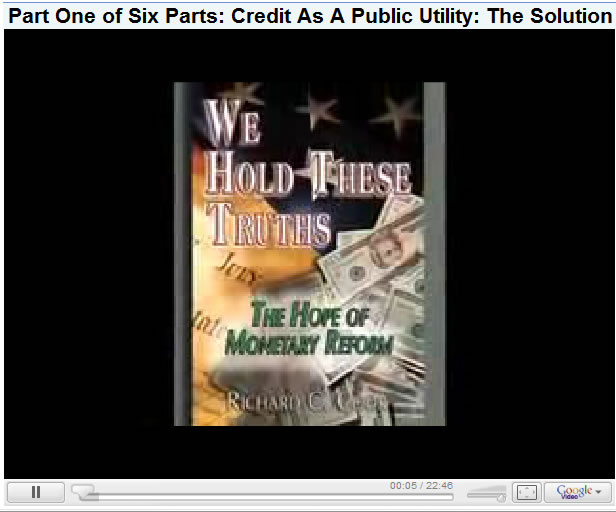Credit as a Public Utility: The Solution to the Economic Crisis
Politics / Credit Crisis 2009 Mar 29, 2009 - 01:47 PM GMTBy: Richard_C_Cook
 A Video in Six Parts Written and Produced by Richard C. Cook
A Video in Six Parts Written and Produced by Richard C. Cook
Part One of Six Parts: Credit As A Public Utility: The Solution to the Economic Crisis
“Our Early Political Leaders Warned Us Against the Banking Interests”
Summary: Early U.S. statesmen, such as Benjamin Franklin, Thomas Jefferson, James Madison, and Andrew Jackson worked to free the nation from control by the bankers who had been behind the establishment of the First and Second Banks of the United States. During the Civil War, President Abraham Lincoln implemented a true democratic currency by spending Greenbacks directly into circulation without borrowing from the banks. These measures allowed the U.S. to develop for much of the 19th century largely free from bankers’ control. By the end of the century, this had changed, and the bankers were taking over.
Part Two of Six Parts: Credit As A Public Utility: The Solution to the Economic Crisis
“The Federal Reserve System: The Bankers Take Over”
Summary: President Lincoln’s Greenback system worked but was undermined and replaced by the financiers who got Congress to pass the National Banking Acts of 1863 and 1864, then the Federal Reserve Act of 1913. The United States now became a nation dominated by the financial elite, the banks, and a debt-based monetary system. Consequently, the 20th Century was one of constant cycles of inflation and deflation resulting in the economic chaos we see today.
http://video.google.com/videoplay?docid=7247440563842157664
Part Three of Six Parts: Credit As A Public Utility: The Solution to the Economic Crisis
“The Collapse of the Financial System”
Summary: The collapse we are seeing today began in the financial system, not the producing economy. The crisis started with the housing bubble which the Federal Reserve created by cutting interest rates and then brought own by raising them. The trigger of the 2008 bank meltdown was refusal by European banks to purchase any more “toxic” U.S. debt based on mortgages and sold as securities. Now, with the decline in equity values, the burden of debt in our economy has grown even larger. Thus a renewal of bank lending will not solve the problem, while the economic stimulus program of the Obama administration is likewise insufficient to restore economic health.
http://video.google.com/videoplay?docid=-2586504549221421168
Part Four of Six Parts: Credit As A Public Utility: The Solution to the Economic Crisis
“What is Credit and Who Should Control It?”
Summary: Fractional reserve banking is the process by which banks create credit out of thin air. But despite abuses of the system, credit is still a crucial part of modern economics. An enlightened concept of governance would view credit as a public utility. This means that government must take back the control of credit from the private financiers.
http://video.google.com/videoplay?docid=-4061589997977265938
Part Five of Six Parts: Credit As A Public Utility: The Solution to the Economic Crisis
“The Gap Between Prices and Income”
Summary: One of the most important and least understood concepts in modern economics is the existence of a gap between prices and purchasing power. This gap results when a portion of prices must be set aside as business and private savings. The money is then used by the financial system for lending and speculation. Keynesian economics takes control of some of the savings through government deficit spending but is still a compromise with control of the economy by the financiers. In fact Keynesian economics has helped cause the collapsing debt pyramid. A better system would be to provide consumers with a National Dividend as a way to monetize the continuous appreciation of the producing economy.
http://video.google.com/videoplay?docid=3035089455833762689
Part Six of Six Parts: Credit As A Public Utility: The Solution to the Economic Crisis
“The Greenback and National Dividend Solutions”
Summary: The U.S. should convert to a system where the money supply is created by the federal government by being spent into circulation without government borrowing or taxation as was done with the Greenbacks. The Federal Reserve should no longer be a bank of issue. Additionally, a National Dividend should be paid directly to the people. The “Cook Plan” calls for the initial distribution of vouchers in the amount of $1,000 a month plus a new system of community savings banks. Greenbacks combined with a National Dividend will create a non-inflationary democratic currency and transform the economy of the United States.
http://video.google.com/videoplay?docid=2945437690287937254
By Richard C. Cook
http:// www.richardccook.com
Copyright 2009 by Richard C. Cook
Richard C. Cook is a former U.S Treasury analyst who also worked in the Carter White House and for NASA and writes on public policy issues. His new book is We Hold These Truths: The Hope of Monetary Reform (Tendril Press 2009). His website is http://www.richardccook.com He is a member of the U.S. Basic Income Guarantee Network and has been an adviser to Congressman Dennis Kucinich and the American Monetary Institute http://www.monetary.org
Richard C. Cook Archive |
© 2005-2022 http://www.MarketOracle.co.uk - The Market Oracle is a FREE Daily Financial Markets Analysis & Forecasting online publication.




